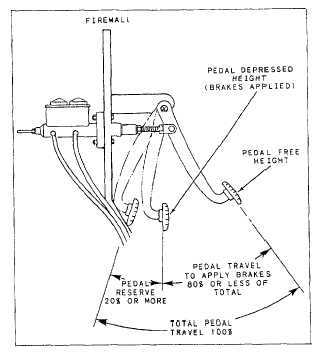manufacturers recommend pulling two wheels-one on each side. Look for loose or broken brake shoe retracting springs, worn clevis and cotter pins in the brake operating mechanisms, and grease or oil leaks at the wheel bearing grease retainer. Check for any signs of brake fluid leakage around the wheel cylinders or caliper operating pistons.
Brake linings that pass inspection for wear must be securely fastened to the brake shins and free from grease and oil. Small grease or oil spots can be removed from the lining with a nonoil base solvent. Linings saturated with grease or oil should be replaced only after the source of contamination has been repaired.
Badly worn or scored brake drums/rotors (fig. 6-2) should be machined smooth and true on a lathe or replaced. Cracked brake drums (fig. 6-3), or brake drums that have been machined beyond their maximum allowable diameter should be discarded. Brake drums and discs have the maximum or discard diameters cast into their outer surfaces (fig. 6-4).
Brake shoe and drum trouble not immediately evident when the wheels are pulled, yet that is detected during road tests, may be caused by the wrong kind of lining, ill-fitting brake shoes, or brake drums slightly out of round. The clue to these troubles may be chattering, spongy, or grabbing brakes.
CAUTION
Before troubleshooting brake systems by road testing, be sure that the vehicle is mechanically sound. Different size tires, low tire pressures, faulty shock absorbers, loose wheel bearings, and worn front-end parts may each indicate brake problems where there are none.
Navy vehicles seldom have the wrong kind of brake lining. However, an inexperienced mechanic may reverse the primary and secondary shoe on one of the wheels or interchange them between wheels so that the shoes are not exactly mated with the drums against which they expand. If you replace shoes or machine the drum/rotor on one side, do the same to the opposite side to prevent pull or loss of control.
The preceding paragraphs apply to most braking systems but do not list all of the problems you will have. For other probable causes of trouble and their remedies in standard hydraulic brake systems, refer to table 6-1.
PEDAL GOES TO THE FLOOR (LOW PEDAL)
Pedal reserve (fig. 6-5) is the distance from the brake pedal to the floorboard with the brakes applied. Low or no pedal reserve indicates brake problems. When there is no pedal reserve or an unlikely occurrence with a dual master cylinder, it could mean anything from a lack of brake fluid, to worn brake linings, a faulty master cylinder, or only a simple brake adjustment. Each of these conditions demands that you closely inspect the brake system.
BRAKES DRAG
Dragging brakes are caused by the following: one or more sets of shoes being adjusted too tightly, broken or weak return springs, a wheel cylinder piston that is stuck, drums that are out of round, defective lining material, loose anchor pins, or clogged lines or hoses. When both rear wheels drag, the cause may be the parking cable linkage being adjusted too tightly or a frozen parking brake cable. All wheels dragging can be the result of a stuck master cylinder pedal linkage or a defective power booster.

Figure 6-5.-Example of pedal reserve.
Continue Reading